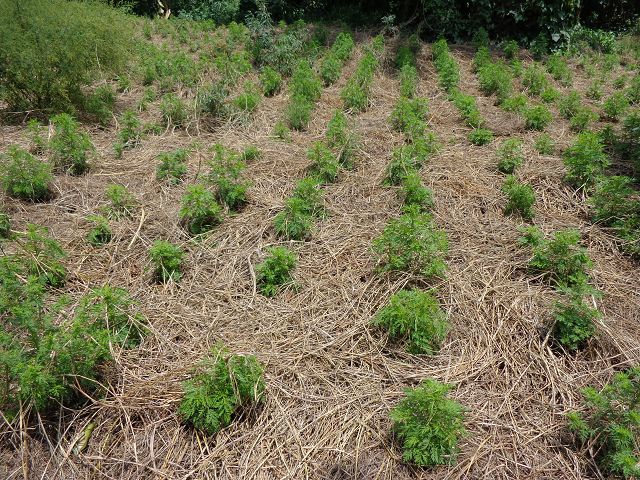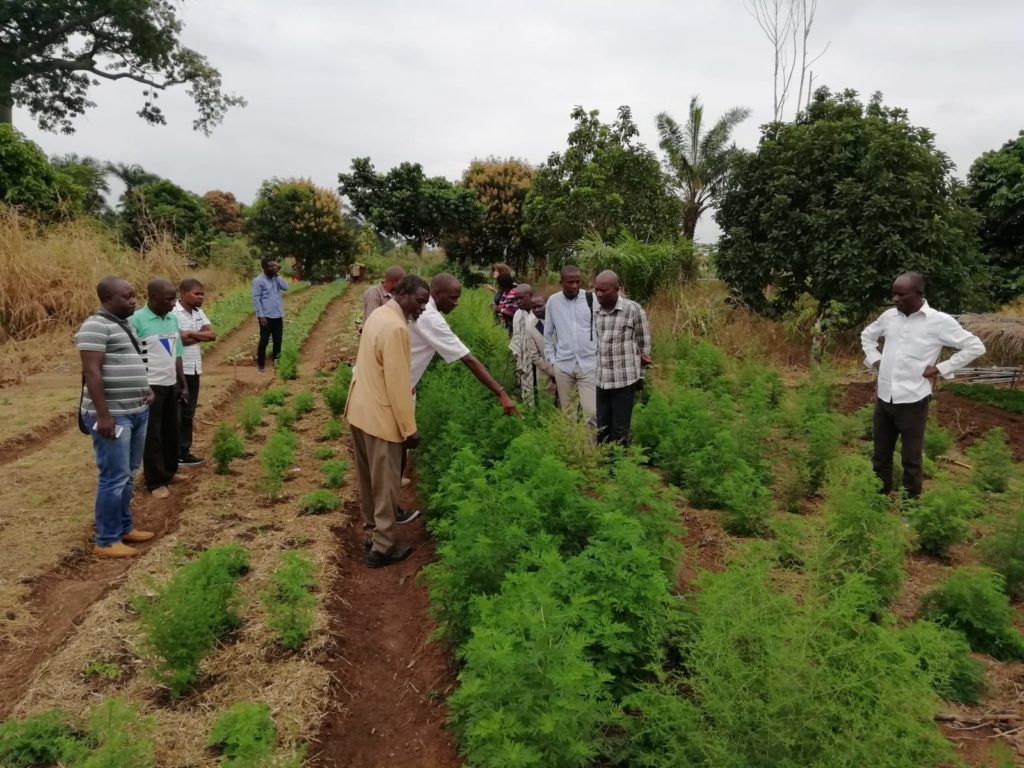Cultivation Artemisia annua
Download in pdfThe principles of good agricultural management, including appropriate crop rotation according to environmental requirements,
must be respected, and ploughing must be adapted to plant development and other crop needs. Where appropriate, conservation agriculture (agro-ecology) should be used, particularly with regard to the accumulation of organic matter (compost, mulching) and conservation of soil moisture (mulching, sustainable irrigation). [1]
Farmers should adopt practices that contribute to soil conservation and reduce erosion, such as creating buffer zones along watercourses, planting cover crops and adding green plant matter (to be incorporated into the soil when ploughing) [1].
These agro-ecological techniques are described in the AGRISUD Guide [3].
Preparation of the plot

Prepare the plot for transplanting at the same time as the seedbed. These operations are labor intensive and can be time consuming. They should be done about 2 months before planting.
if possible, the growing area to avoid damage from wandering animals.
Cattle should not be allowed to enter the growing area [1].
only if necessary. Avoid slash-and-burn agriculture which destroys soil life!
to remove stones and weeds.
if the soil is poor (see AGRISUD Guide [3] p 97 to 103 - Organic manure).
to loosen the soil and form cultivation beds or ridges as appropriate.
(drainage channels) to drain the soil if the crop is grown in the rainy season.
WHO recommends that soil should contain appropriate amounts of nutrients, organic matter and other elements [1].
Ideally, a soil test should be performed and the results recorded in the batch and cultivation record.
Add manure to the soil, preferably 2 weeks prior to transplanting.
This does not dispense you from adding compost and manure as part of regular plant care.
Transplanting

approximately one hand deep (approx 20 cm, depending on the roots).
generously to loosen the soil and facilitate transplanting and recovery of young plants (in an intensive cultivation system with irrigation, irrigate the plot for 4 hours, about 15mm).
to remove any lumps and mix in a large handful of compost (approx 200 g).
Use of mineral fertiliser (including urea and NPK) is not allowed in organic farming!
As nitrogen (N) is a determining factor in the growth of Artemisia annua, it is possible to add ground horns (from slaughterhouses) to the compost.
the seedbed to loosen the soil before removing the plants.
the seedling, keeping a clod of earth around the roots!
2 large handfuls of compost in a circle around each plant to promote lateral root growth
IMPORTANT: Do not cover the leaves to avoid the risk of burning!
The doses to be applied are the same as those traditionally used in market gardening. The staggered application of 1 kg of poultry manure compost per plant gives very good results. It is essential to adapt the type of manure taking into account the specific growing conditions of the region: soil type, climate, possible irrigation. Nitrogen appears to be the determining nutrient in the growth of Artemisia annua. [2]
Nutrient inputs differ according to the type of compost. Compost made with poultry droppings provides about 3 times more nitrogen than compost made with donkey manure, cattle manure, pig manure or green waste. Triple doses of non-poultry manure compost!
Manure must be carefully decomposed to meet health standards for acceptable limits of microbial contamination and to destroy the germination capacity of weeds. Human excrement should not be used as fertiliser because of the possible presence of infectious microorganisms and parasites. Any application of manure should be documented. [1]

Optimal planting density depends on several factors:
Variety, soil type, period of the year, manure used, association or not with another crop, technical itinerary, … [2]
Planting at a density of 2 plants/m² (100 x 50 cm) in rows 1 m apart with 50 cm between plants to promote growth and limit the occurrence of fungal disease has proved best in Senegal under favourable conditions (fertile soil, no water stress, vigorous genotype and not too short day length) [2].
In less favorable conditions, density can be increased to 4 plants/m² (50 x 50 cm).
We advise against monoculture over a large area. These measures should be adapted by alternating Artemisia with market gardening and subsistence crops.
Mulching
Mulching the lines with fresh or dry organic matter (green plant waste) helps limit the need for water and weeding, reduces soil erosion, provides additional nutrients and prevents the soil from dirtying the lower branches of the Artemisia annua plants.
Use any type of straw, tops, grasses, cereal crop residues, cut or crushed corn plants, decomposed palm oil leaves … Avoid woody material that attracts termites. Favour local reclaimed products!
(See Guide AGRISUD [3] p 143 to 144 – Mulching).
For example, citronella can be pruned every 15 or 21 days to produce the necessary mulch.
In Togo, RCW (Ramial Chipped Wood) gave good results with rice straw, palm branches, young green branches of Moringa and Neem.
A system of cultivation on plant cover or using cover plants can also be considered (see Guide AGRISUD [3] p 197 to 207).

Plant care
- Water each plant generously morning and evening every day using a watering can, sprinkler or drip.
- Irrigate early in the morning and late in the evening or at night to reduce evaporation and consequent water loss.
IMPORTANT: Do not flood the soil, but moisten it well. Artemisia annua is sensitive to waterlogging and water stress is fatal to young plants, causing early flowering and consequently stopping plant growth!
- Weed regularly after transplanting and then every month.
IMPORTANT: remove all weeds as Artemisia annua is very sensitive to competition!
- Monitor plants regularly and act quickly in case of disease (such as the appearance of mould if watering is too heavy) or pests (goats, rabbits, cattle, termites, grasshoppers, …)!
- Replace dead plants several times during the first 2 months in the field.
- If necessary, provide shelter from the sun or wind when young plants are first planted out.
Don’t worry about variations in plant shape and height.
In the La Maison de l’Artemisia network, we use free farm-saved seed, which has considerable genetic variability. What’s more, Artemisia annua has variable morphologies depending on its environment. We take advantage of this diversity to adapt Artemisia to each growing condition. By selecting a good seedbed, you can be sure of more beautiful, more homogeneous, less stressed and more productive offspring at home (massal selection principle). During the first trials, it is very common to have a large number of early flowering plants due to a lack of adaptation to local growing conditions.
BEWARE of early flowering! Make sure it is not due to water stress (excess or lack of water), too much sun, the physical impact of water on the plant or wind.
It is possible to cut back only the part of the plant that is flowering. When conditions return to more favourable levels, if daylight is not too short, the plant can stop flowering and resume its vegetative growth [4].
Since herbal tea must be harvested BEFORE fruiting, it is essential to harvest stressed plants as soon as the green flower buds or yellow flowers appear (see stages in the Artemisia annua, Artemisia afra and harvesting sheets). It is pointless and even counterproductive to harvest seeds from plants that are not very productive or that flower early. They will produce less productive or even unsuitable offspring.

After 2 weeks in the field, when the plants reach a height of 30 to 50 cm, plants can be coppiced or pruned by cutting 5 to 10 cm off the top. Topping will produce more productive plants with more branches. This harvest can be used for its health benefits as well as the final harvest. [5]
Bibliography:
1. World Health Organisation. WHO monograph on good agricultural and collection practices (GACP) for Artemisia annua L. 2006.
http://www.who.int/malaria/publications/atoz/9241594438/en/
2. Sougnez A. Étude des principaux facteurs de la production de l’armoise annuelle (Artemisia annua L.) sur le domaine de l’organisation « Le Relais – Sénégal) : Effet de la densité et de la fertilisation. Master’s thesis bioengineer in agronomic sciences, under the supervision of Pr. Guy Mergeai, Gembloux, Gembloux Agro-Bio Tech (ULiège). 2017. (Study of the main factors in the production of annual mugwort (Artemisia annua L.) in the field at “Le Relais – Senegal: Effect of density and fertilisation).
3. AGRISUD. L’agroécologie en pratiques – GUIDE édition 2020. 2020. (Agroecology best practices)
http://www.agrisud.org/wp-content/uploads/2020/04/Agrisud_Guide_Agroecologie_2020.pdf
4. Mergeai Guy. Research professor at Gembloux Agro-Bio Tech (Faculty of Agronomic Sciences at the University of Liège). Observations reported.
5. Guidigan D. Effet de l’urée et de l’étêtage sur la production de phytomasse et le développement phénologique de l’Artemisia annua Anamed au Sud Bénin : Cas de la ferme d’application et de production de la FSA sise à Sékou. Master’s thesis presented for the professional bachelor’s degree in agronomic sciences, option Aménagement et Gestion des Forêts et Parcours Naturels (AGFPN), under the supervision of Dr. Ir. Oscar TEKA, Université d’Abomey-Calavi. 2016. (Effect of urea and topping on phytomass production and phenological development of Artemisia annua Anamed in South Benin).
https://valtramed.com/wp-content/uploads/2017/11/memoire%20Darling.pdf










